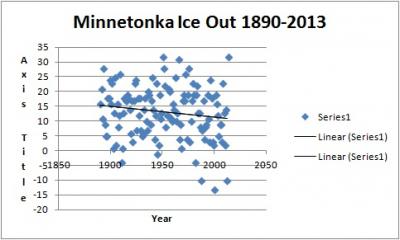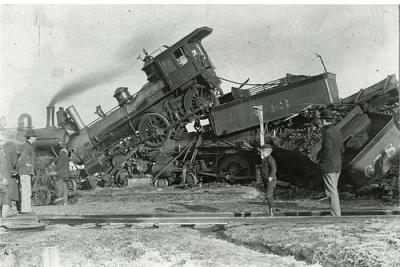Quote:
My brain cell is tired.

I think mine popped.
IDO » Forums » Fishing Forums » General Discussion Forum » Climate Change Effects on Lake Minnetonka
Quote:
Quote:
My brain cell is tired.

I think mine popped.
uh oh, I hope it didn’t release any CO2
Salamanders Disappearing Because of Global Warming
Quote:
The scientists haven’t yet confirmed that the salamanders’ smaller size is behind the documented population declines, though they are confident that climate change is what’s driving the shrinkage in body size.
I swear no scientist can be objective in any natural science because they are predisposed to conclude everything is the result of global warming. And that is a REAL danger.

..last one
Quote:
Runoff is the biggest contributor to algae blooms. If anyone is concerned with algae, I suggest they focus on changing agricultural practices.
Fallacy
Quote:
Quote:
Runoff is the biggest contributor to algae blooms. If anyone is concerned with algae, I suggest they focus on changing agricultural practices.
Fallacy
So excess nutrients going into bodies of water has nothing or less to do with algae blooms than warmer water, longer warm water seasons?
Is this where I bet $50 and ask for a linear regressive chart?
Quote:
Quote:
Quote:
Runoff is the biggest contributor to algae blooms. If anyone is concerned with algae, I suggest they focus on changing agricultural practices.
Fallacy
So excess nutrients going into bodies of water has nothing or less to do with algae blooms than warmer water, longer warm water seasons?
Is this where I bet $50 and ask for a linear regressive chart?
Yeah, I gotta think all the grass clippings soaked in Trugreens secret sauce has a bit of effect.
How will you make good on the wager? Trend = 0.035 days earlier ice out per year, about 4.5 days earlier over the 124 years 1890-2013.

a bag of organic fertilizer (produced by male domestic bovine) would probably be the most appropriate for any wager originated via a “debate” on an internet messge board
Quote:
How will you make good on the wager? Trend = 0.035 days earlier ice out per year, about 4.5 days earlier over the 124 years 1890-2013.
And I quote
Quote:
Be sure to provide everything to back up whatever data you put forth.
Where is the tabular data?
Also, can you please include labels for the axis and legend, that’s a pretty sloppy chart. How can I trust someone who doesn’t even take the time to label his charts.
It’s rather useless to hang one’s hat on data gathered in multiple ways, is subjective at best and at worst based on when a car fell through the ice.
http://freshwater.org/wp-content/uploads/2013/03/dickgray2003columnonice-out.pdf
Argument over. 
Quote:
Quote:
How will you make good on the wager? Trend = 0.035 days earlier ice out per year, about 4.5 days earlier over the 124 years 1890-2013.
And I quote
Quote:
Be sure to provide everything to back up whatever data you put forth.
Where is the tabular data?
Also, can you please include labels for the axis and legend, that’s a pretty sloppy chart. How can I trust someone who doesn’t even take the time to label his charts.
Can this be continued at a Perkins with a live webcam? 
A Perkins ?
How is that gonna determine anything ?
Put ’em both in a feedlot, give ’em each a shovel, and whoever can pile the most cubic yards into a dumptruck in a day wins.
and by the way, so does the water quality in the local lakes … because we can then use the results of this contest for local lawn enhancement (instead of TruGreen secret sauce)
Quote:
How will you make good on the wager? Trend = 0.035 days earlier ice out per year, about 4.5 days earlier over the 124 years 1890-2013.
Which data did you decide to leave out this time to prove your point?
If you don’t like the way I presented the trend, do the calculations yourself. I never expected you would make good on the wager when presented with the evidence.
Quote:
How will you make good on the wager? Trend = 0.035 days earlier ice out per year, about 4.5 days earlier over the 124 years 1890-2013.
I studied economics and accounting in school. All that graph tells us is that there is no identifiable trend. Using year to determine ice out dates has a very low probability of success.
Yes, you can make a regression equation “fit” any data, but you have to acknowledge when the results are worthless.
Quote:
Quote:
How will you make good on the wager? Trend = 0.035 days earlier ice out per year, about 4.5 days earlier over the 124 years 1890-2013.
Which data did you decide to leave out this time to prove your point?
Every year from 1890-2013 is included.
Quote:
Using year to determine ice out dates has a very low probability of success.
Huh? Success of what?
Send me the data to chart so I can compare it against the data originally presented like I originally requested. And for goodness sakes, put some damn labels up as I requested.
This isn’t climate science where you can just show a chart and demand we take your word for it.
Quote:
If you don’t like the way I presented the trend, do the calculations yourself. I never expected you would make good on the wager when presented with the evidence.
You are a very, very serious person.
^^^ For those of us slow to the table…that was funny Don!
Part of me wants to tell you guys to take it off line, but the other part of me likes watching train wrecks.
Keep it above the belt and all is good. 
I’ll be here all week folks 
and now for a something completely different 

so if train A left St Anthony MN headed west bound at 70 mph and train B left Hutchinson MN headed east bound at 80 mph, on what day next year will the Lake Minnetonka ice out occur 
^ I’ll cover Pug’s wager if anyone can accurately/adequately graph it (disclaimer: pmt will be in “FishBucks”)
I’d like to ask for the standard error, confidence intervals and R^2 to be included with these stats. 
You must be logged in to reply to this topic.